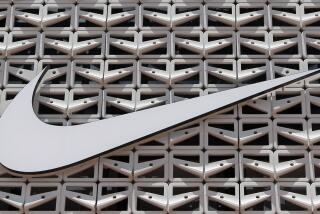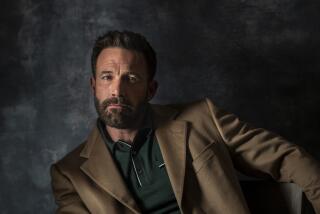Flying High With Air Jordan : Nike: Company’s products line takes off, but Reebok becomes No. 1. Sonny Vaccaro is told that he is quitting.
On the last night of Nike’s annual week-long trip for college basketball coaches in August, 1986, a 1920s-style speak-easy was set up in an immense tent at the La Costa resort in (Carlsbad). As a ‘20s band played, more than 100 party-goers mingled, including some of basketball’s best: Michael Jordan, Artis Gilmore, Moses Malone, Abe Lemons, Billy Cunningham, Lou Carnesecca, P.J. Carlesimo and Jim Valvano.
After the cocktail hour, guests sat down to dinner at tables adorned with white linen, white orchids and silver. The centerpieces were lighted vases filled with water in which live goldfish swam. On each china plate was a party favor: a loaded, oversized squirt gun.
As waiters dressed in formal attire began serving the first course, the inevitable happened. Gangs formed. Shirts were soaked through. Makeup ran. Even Deloris Jordan, a woman of notable decorum, took aim. Her son, Michael, took up a post outside the speak-easy door, picking off targets through the small window.
Michael Jordan had been determined to sign with Adidas when he left North Carolina and joined the Chicago Bulls in 1984. Even as he sat in the back seat of a Nike limo, watching a Nike video of his moves set to the music of the Pointer Sisters’ “Jump,” he had been plotting how to get Adidas’ three stripes on his feet.
But Nike had developed an Air Jordan package that marked the first time a sporting goods company had ever tied shoes and clothes together for a team athlete who, unlike a tennis player or golfer, had to play every game in a uniform. Michael’s parents told him Nike’s money was right, the chemistry was right, and that it looked like Nike could be fun as well as business. Michael, finally, agreed.
Air Jordan had proved the most successful athlete endorsement in history, selling more than $100 million in a single year and helping Nike hit its first billion-dollar year in 1986.
But Nike had never measured its success in dollars or earnings per share. It had measured its success by wins and losses. And now Nike was losing. A new company named Reebok, riding to success on the heels of soft white aerobics shoes, was heading toward a 30% market share; Nike was hanging on to 21%. Before the analysts made it official, Philip Knight acknowledged to his top men that Reebok was the top athletic footwear company in America. Nike, he said, was now “No. 2.”
Knight, Bob Woodell, Del Hayes and Rob Strasser (Nike’s “Gang of Four”) had briefly talked about selling the company in 1983. Now that Nike was down, that talk resurfaced.
There were times when Hayes questioned Knight’s stick-to-itiveness, and wondered if they should sell the company. But he never recommended it. There was a difference, Hayes felt, between being in second place and dropping out of the race altogether. If Knight were to sell now, when the chips were down, Hayes couldn’t imagine Knight ever escaping the stigma of his perceived failure.
At the end of the summer of 1986, Knight stopped just short of signing a letter of intent to sell. When push came to shove, Hayes had to admit, selling the company was emotionally much easier said than done. And not just for Knight. For all of them.
By early 1987, the new $100 Air Jordan shoe wasn’t selling. It was the old chicken-and-egg question. It wasn’t selling because Nike wasn’t putting dollars behind it. And Nike wasn’t putting dollars behind it because it wasn’t selling. Michael Jordan wasn’t even being used to push his own line.
On May 20, 1987, Strasser and Peter Moore found themselves in a small meeting room at the Airport Sheraton in Charlotte, N.C. With them was the same team that had developed Air Jordan nearly three years earlier: Jordan’s agent David Falk, Nike basketball promo man Howard White and Jordan and his family. Strasser and Moore proposed creating a whole new category of Jordan products on the edge between sportswear and casual wear, put his name on them and make “Michael Jordan” a label.
“Peter’s going to explain what the products will look like, and then we’ll vote. There’s only one vote that really counts . . . ,” said Strasser with a sideways look at Jordan.
“Yeah, yours,” said Michael, flashing his famous smile as the rest laughed. Jordan had come a long way from his first meeting with Nike, where he had sat stone-faced. Jordan was growing up. Although inexperienced, he now contributed to the Nike meetings and, Strasser felt, demonstrated a damn good instinct for business.
Moore felt Nike needed to jettison the first Air Jordan logo he had drawn three years before--a basketball flanked by a pair of wings--and create a far more sophisticated one that reflected the change in Jordan himself.
“The wings look juvenile now,” he said, unveiling a silhouette of Jordan’s famous poster dunk. Fingers outspread, legs open like a scissors. Reduced in size and embroidered on a shirt, Moore felt the “Jump Man” logo took on an attitude of a Ralph Lauren horse.
When Knight saw the proposal, he appeared to like it, but gave no charter for action.
When Strasser had joined Nike 14 years before, he had told Knight it was because he considered him a friend, and if that ever changed, he would leave. When he needed Knight to make a decision one day, and Knight kept telling him he’d deal with it later, it was the final straw. He (Strasser) joined the growing number of entrepreneurs who had left the company they had helped build.
Michael Jordan watched the team that he had worked with on Air Jordan leave Nike. When he heard that Moore had left a vice president position and what amounted to a small fortune in stock options on the table to start up a consulting company from nothing with Strasser, Jordan rolled on the floor of Strasser’s apartment laughing. By 1988, Knight wrote in his shareholders letter that “all of the vice presidents listed in the 1981 annual report have left.”
Now that Strasser and Moore were gone, Jordan felt his Air Jordan line would never get attention again at Nike. The more Jordan thought about it, the more he wanted a company of his own anyway. He knew he wasn’t going to play basketball forever. He wanted something else he could do with his life when the time came. The idea of having a sportswear company sounded good.
His Nike contract was up for renewal in 1988.
Jordan, Strasser and Moore met in Portland to talk about it. They agreed that Jordan should not leave Nike under any circumstances, that he should never play basketball in another company’s shoes.
But they also agreed that Nike had never acted on the idea of casual sportswear and shoes under a Jordan label, so Nike had nothing to lose if Jordan decided to start his own casual wear company. They came up with a plan for Jordan to play in Nike shoes and wear Nike athletic clothes for a very reasonable price for the remainder of his basketball career. In exchange, Nike would help finance the start-up of Michael Jordan, Inc.
Jordan walked into Knight’s office in a three-piece suit carrying a briefcase. Strasser and Moore followed. Jordan opened the session by saying he wanted to start his own company, just as Knight had started his, and that he hoped Nike would be a part of it. Then, he laid out the plan.
“That’s not possible,” Knight said when Jordan finished speaking. “We’re not going to do that.”
Strasser tried to explain that perhaps they could come up with another plan.
“Michael Jordan without Nike won’t mean anything,” Knight said.
To Jordan, those words felt like an attack. It was obvious to him that Knight thought he was incapable of having a thought of his own. Jordan felt insulted, treated as if he were just a “puppet” into which the other two men had put words.
But Jordan also realized in that meeting that Knight wouldn’t have gone for the idea no matter who he walked in the door with. Knight’s ego was part of the reason, Jordan thought; greed seemed to be another. Knight, he decided, didn’t want to share any piece of Nike’s pie.
Over the next year, Jordan tried to find a way to make his new company idea work. If Strasser and Moore had assured him that he would eventually make more money on his own company, he would have dumped Nike. But they couldn’t, and they didn’t. When Nike offered Jordan a reported $20 million, Strasser and Moore told him to take the money. So did his parents. On his birthday, in March, 1989, Jordan signed his Nike contract, which essentially guaranteed that his entire basketball career would be played in Nike shoes.
In 1990, Jordan and Nike basketball men Sonny Vaccaro and Howard White were sitting in a cafe on the Champs Elysees in Paris during Jordan’s European Nike tour. There were seven people Jordan had dealt with at Nike over the years. Only two were left: Vaccaro and White.
“You guys can’t leave Nike until I leave,” Jordan said that day. “We are the last of the Mohicans. We can’t let them run us out.”
Sonny Vaccaro had no idea that almost exactly one year later he would recall those words and realize they had foreshadowed the future. By then, Nike’s college basketball program had become a powerful source of revenue and publicity for Nike’s $500 million in basketball sales. Some publications were calling Vaccaro himself the most powerful man in college basketball.
As he had done for the past 13 years, Vaccaro played host to the week-long coaches’ trip in August, 1991. He and Knight briefly discussed Vaccaro’s latest side venture, a firm that specialized in putting together product endorsement packages for coaches and athletes. Knight invited him up to Oregon to discuss how Nike would fit into his new plans.
But when he arrived, Knight opened by saying that Vaccaro had made a career decision that no longer included Nike. Vaccaro was confused about Knight’s sudden change of heart. Then it hit him: Knight had planned all along to squeeze him out of Nike. That was why he had invited new Nike vice president Tom Clarke on the trip this year--to get the coaches familiar with Nike’s new coat-and-tie brigade.
“I feel like a gunslinger in the Old West,” Vaccaro told Knight. “The townspeople hired a gunslinger--me--to clean up the town and turn it into something they were proud of. Now, those townspeople no longer want the gunslinger around because he just doesn’t seem to fit their new image.”
“That’s right,” said Knight.
Vaccaro felt more than than hurt, more than anger. He felt betrayal.
“Well,” he said. “I guess you’ve probably already arranged things like severance.” “You won’t be getting a severance,” Knight said. “You quit.”






